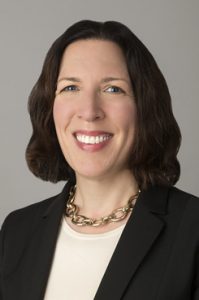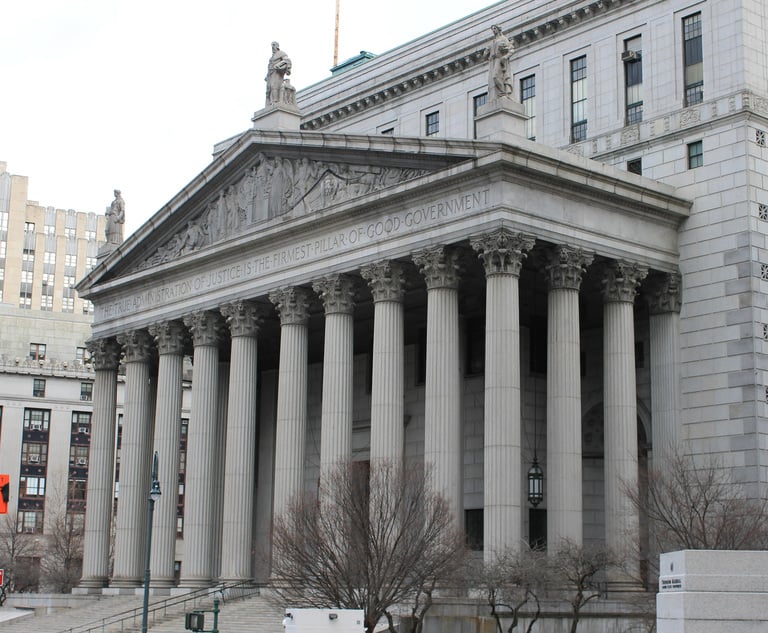Gibson Dunn Snags Saharsky From Solicitor General's Office
Nicole Saharsky, who has argued 29 cases before the U.S. Supreme Court as an assistant to the U.S. solicitor general, is joining Gibson, Dunn & Crutcher as a partner and co-chair of the firm's appellate and constitutional law practice group.
November 01, 2017 at 01:32 PM
34 minute read

Nicole Saharsky, who has argued 29 cases before the U.S. Supreme Court as an assistant to the U.S. solicitor general, is joining Gibson, Dunn & Crutcher as a partner and co-chair of the firm's appellate and constitutional law practice group.
Among women in current practice at the high court, other than Saharsky: Lisa Blatt of Arnold & Porter Kaye Scholer, who has argued 35 times.
 Nicole Saharsky
Nicole Saharsky“This is a great move for Gibson Dunn,” said former Solicitor General Donald Verrilli Jr., who worked with Saharsky for five years in the SG's Office. “She is a brilliant lawyer, a superb and experienced oral advocate, and, most importantly, a person of great character and integrity.” Verrilli is now a partner at Munger, Tolles & Olson.
Saharsky's move follows in the footsteps of other former SG assistants who have walked into leadership positions at top Supreme Court firms. Think Blatt, Pratik Shah of Akin Gump Strauss Hauer & Feld, Kannon Shanmugam of Williams & Connolly, Deanne Maynard of Morrison Foerster, William Jay of Goodwin & Procter, and Douglas Hallward-Driemeier of Ropes & Gray, among others.
Other co-chairs of Gibson Dunn's appellate practice are James Ho, Mark Perry and Caitlin Halligan. Ho's nomination to the U.S. Court of Appeals for the Fifth Circuit is pending.
“Nicole is an experienced Supreme Court advocate of the first order,” Perry said in a press release. “The demand for the group's services continues to grow, and we are looking forward to working with Nicole to meet that demand.”
Ken Doran, the firm's chairman and managing partner, also said, “Nicole is a very experienced and extraordinarily talented appellate litigator who enjoys a well-deserved reputation before the Supreme Court as an extremely effective advocate.”
In an interview, Saharsky said she left the Solicitor General's Office on Sept. 15 and her first day at Gibson was Tuesday. In the interim, she took a trip to Bhutan in South Asia, “about as far away as you can get.”
She said her 10 years at the SG's Office is “a long time by standards of the office,” and she felt it was time to look for other opportunities. She sought a firm that provided the combination of “great people and great work,” and found it at Gibson, she said.
In the press release she also stated, “The firm is home to one of the country's premier appellate groups, and I am thrilled to become a part of such a talented group.” Saharsky declined to discuss financial arrangements.
Before joining the SG's Office 10 years ago—she was hired by former SG Paul Clement— Saharsky was an associate at O'Melveny & Myers. She also served as a Bristow fellow in the Solicitor General's Office and clerked for Fifth Circuit Judge Carolyn Dineen King.
She argued in a wide range of cases, from last term's jurisdiction case BNSF Railway v. Tyrrell to the 2012 Fourth Amendment “dog sniff case,” Florida v. Jardines.
♦ READ MORE: Why Are There So Few Women SCOTUS Advocates?
As devotees of Supreme Court trivia will remember, Saharsky gained early notoriety in 2008 when she added a new word to Chief Justice John Roberts Jr.'s vocabulary.
During oral arguments in United States v. Hayes, involving a federal firearms statute, the justices were discussing different parts of the statute 18 U.S.C. 922 (a)(33)(A)(i) and (ii), referring to the sections awkwardly as “little eye” and “little eye eye.”
But Saharsky, representing the government, used a different approach. She called them “Romanette one and two,” using an obscure but self-explaining and almost whimsical term for a lower-case Roman numeral.
“Romanette?” Roberts asked quizzically.
“Oh, little Roman numeral,” Saharsky replied offhandedly.
“I've never heard that before!” Roberts said.
The word, fairly obscure until then, became a thing in legal circles.
Roberts used it again in an oral argument, and Kirkland & Ellis' legal trivia team called itself “The Romanettes,” attributing the name to Saharsky's mention of the word in the high court.

Nicole Saharsky, who has argued 29 cases before the U.S. Supreme Court as an assistant to the U.S. solicitor general, is joining
Among women in current practice at the high court, other than Saharsky: Lisa Blatt of
 Nicole Saharsky
Nicole Saharsky“This is a great move for
Saharsky's move follows in the footsteps of other former SG assistants who have walked into leadership positions at top Supreme Court firms. Think Blatt, Pratik Shah of
Other co-chairs of
“Nicole is an experienced Supreme Court advocate of the first order,” Perry said in a press release. “The demand for the group's services continues to grow, and we are looking forward to working with Nicole to meet that demand.”
Ken Doran, the firm's chairman and managing partner, also said, “Nicole is a very experienced and extraordinarily talented appellate litigator who enjoys a well-deserved reputation before the Supreme Court as an extremely effective advocate.”
In an interview, Saharsky said she left the Solicitor General's Office on Sept. 15 and her first day at Gibson was Tuesday. In the interim, she took a trip to Bhutan in South Asia, “about as far away as you can get.”
She said her 10 years at the SG's Office is “a long time by standards of the office,” and she felt it was time to look for other opportunities. She sought a firm that provided the combination of “great people and great work,” and found it at Gibson, she said.
In the press release she also stated, “The firm is home to one of the country's premier appellate groups, and I am thrilled to become a part of such a talented group.” Saharsky declined to discuss financial arrangements.
Before joining the SG's Office 10 years ago—she was hired by former SG Paul Clement— Saharsky was an associate at
She argued in a wide range of cases, from last term's jurisdiction case
♦ READ MORE: Why Are There So Few Women SCOTUS Advocates?
As devotees of Supreme Court trivia will remember, Saharsky gained early notoriety in 2008 when she added a new word to Chief Justice John Roberts Jr.'s vocabulary.
During oral arguments in United States v. Hayes, involving a federal firearms statute, the justices were discussing different parts of the statute
But Saharsky, representing the government, used a different approach. She called them “Romanette one and two,” using an obscure but self-explaining and almost whimsical term for a lower-case Roman numeral.
“Romanette?” Roberts asked quizzically.
“Oh, little Roman numeral,” Saharsky replied offhandedly.
“I've never heard that before!” Roberts said.
The word, fairly obscure until then, became a thing in legal circles.
Roberts used it again in an oral argument, and
This content has been archived. It is available through our partners, LexisNexis® and Bloomberg Law.
To view this content, please continue to their sites.
Not a Lexis Subscriber?
Subscribe Now
Not a Bloomberg Law Subscriber?
Subscribe Now
NOT FOR REPRINT
© 2025 ALM Global, LLC, All Rights Reserved. Request academic re-use from www.copyright.com. All other uses, submit a request to [email protected]. For more information visit Asset & Logo Licensing.
You Might Like
View All

Trump's DOJ Delays Releasing Jan. 6 FBI Agents List Under Consent Order
3 minute read

Judge Grills DOJ on Trump’s Birthright Citizenship Executive Order
Trending Stories
- 1Ex-Starbucks GC Exiting Latest Role, Will Get Severance
- 2Family Law Special Section 2025
- 3We Must Uphold the Rights of Immigrant Students
- 4Orrick Picks Up 13-Lawyer Tech, VC Group From Gunderson Dettmer
- 5How Alzheimer’s and Other Cognitive Diseases Affect Guardianship, POAs and Estate Planning
Who Got The Work
J. Brugh Lower of Gibbons has entered an appearance for industrial equipment supplier Devco Corporation in a pending trademark infringement lawsuit. The suit, accusing the defendant of selling knock-off Graco products, was filed Dec. 18 in New Jersey District Court by Rivkin Radler on behalf of Graco Inc. and Graco Minnesota. The case, assigned to U.S. District Judge Zahid N. Quraishi, is 3:24-cv-11294, Graco Inc. et al v. Devco Corporation.
Who Got The Work
Rebecca Maller-Stein and Kent A. Yalowitz of Arnold & Porter Kaye Scholer have entered their appearances for Hanaco Venture Capital and its executives, Lior Prosor and David Frankel, in a pending securities lawsuit. The action, filed on Dec. 24 in New York Southern District Court by Zell, Aron & Co. on behalf of Goldeneye Advisors, accuses the defendants of negligently and fraudulently managing the plaintiff's $1 million investment. The case, assigned to U.S. District Judge Vernon S. Broderick, is 1:24-cv-09918, Goldeneye Advisors, LLC v. Hanaco Venture Capital, Ltd. et al.
Who Got The Work
Attorneys from A&O Shearman has stepped in as defense counsel for Toronto-Dominion Bank and other defendants in a pending securities class action. The suit, filed Dec. 11 in New York Southern District Court by Bleichmar Fonti & Auld, accuses the defendants of concealing the bank's 'pervasive' deficiencies in regards to its compliance with the Bank Secrecy Act and the quality of its anti-money laundering controls. The case, assigned to U.S. District Judge Arun Subramanian, is 1:24-cv-09445, Gonzalez v. The Toronto-Dominion Bank et al.
Who Got The Work
Crown Castle International, a Pennsylvania company providing shared communications infrastructure, has turned to Luke D. Wolf of Gordon Rees Scully Mansukhani to fend off a pending breach-of-contract lawsuit. The court action, filed Nov. 25 in Michigan Eastern District Court by Hooper Hathaway PC on behalf of The Town Residences LLC, accuses Crown Castle of failing to transfer approximately $30,000 in utility payments from T-Mobile in breach of a roof-top lease and assignment agreement. The case, assigned to U.S. District Judge Susan K. Declercq, is 2:24-cv-13131, The Town Residences LLC v. T-Mobile US, Inc. et al.
Who Got The Work
Wilfred P. Coronato and Daniel M. Schwartz of McCarter & English have stepped in as defense counsel to Electrolux Home Products Inc. in a pending product liability lawsuit. The court action, filed Nov. 26 in New York Eastern District Court by Poulos Lopiccolo PC and Nagel Rice LLP on behalf of David Stern, alleges that the defendant's refrigerators’ drawers and shelving repeatedly break and fall apart within months after purchase. The case, assigned to U.S. District Judge Joan M. Azrack, is 2:24-cv-08204, Stern v. Electrolux Home Products, Inc.
Featured Firms
Law Offices of Gary Martin Hays & Associates, P.C.
(470) 294-1674
Law Offices of Mark E. Salomone
(857) 444-6468
Smith & Hassler
(713) 739-1250








